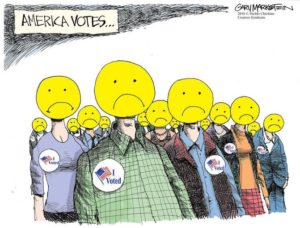
If a nation expects to be ignorant and free in a state of civilization, it expects what never was and never will be —Thomas Jefferson, 1816
200 years ago, Thomas Jefferson hit the nail on the head. He made the connection between a public education system and citizens that take an active part in their government. We seldom consider how important education is to citizens of a free society. Rather we are taught to view educational attainment through the prism of job enhancement and its accompanying economic and social benefits. Jefferson knew there was another, more pressing reason for free public education— “Every government degenerates when trusted to the rulers of the people alone.” As true today as it was 200 years ago.
After the “November surprise,” we the people face unchartered waters where the unthinkable has suddenly become reality, the unexpected the rule and the unprecedented the new normal. How did the candidate that received almost three million more votes than her opponent manage to lose the election? — Voter turn-out. America gets an F when it comes to voter interest, activism, and participation. 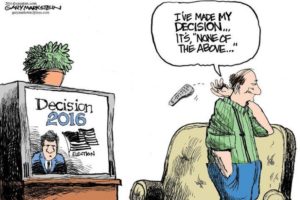 More and more Americans prefer to pull the covers over their heads and let someone else do the heavy lifting. In 2016, over 90 million Americans found some excuse not to vote. Among 35 of the biggest and most prosperous democracies (in one form or another) in the OECD (Organization for Economic Cooperation and Development), the US ranks 31 in voter turn-out.
More and more Americans prefer to pull the covers over their heads and let someone else do the heavy lifting. In 2016, over 90 million Americans found some excuse not to vote. Among 35 of the biggest and most prosperous democracies (in one form or another) in the OECD (Organization for Economic Cooperation and Development), the US ranks 31 in voter turn-out.
In an irony that wasn’t lost on the rest of the world, in the 2016 election Trump’s winning popular vote total was only slightly higher than Romney’s losing vote total in 2012. But popular vote totals don’t decide US elections as Al Gore discovered in 2000 when he won one-half million more votes than Bush and didn’t become President (5 presidential nominees have won the popular vote and lost the election). How did Trump do it? He capitalized on winning majorities in 19 battleground states where voters, reacting to the failed promises of the previous administration, stayed home.
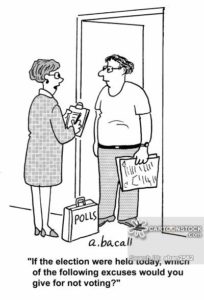
According to one election expert, turn-out rates in states that Hillary Clinton needed to win, dropped — some by as much as 3% (Wisconsin) and 4% (Ohio) — enough of a dip to hand the victory to Trump in both states. To compound Clinton’s problem, she did not run as well among voters traditionally considered the most loyal segments of the democratic base. Blue collar workers, for example, abandoned their fealty to the democrats after the flame-out of the Obama years and either stayed home, went fishing, or re-emerged as Trump donors. Their abandonment of the democratic party played a major role in Clinton’s loss in battleground states —more significant than FBI Director Comey (Clinton blamed her defeat on Comey’s decision to announce publicly that he intended to reopen the investigation into Clinton’s private e-mail server. Most poll watchers discount the impact of his announcement on her eventual defeat).
About now you’re probably thinking “Okay these statistics have been trotted out, hashed and rehashed a gazillion times since November 8. Where’s the beef? What does low voter turn-out and general public disenchantment with both parties have to do with the equally dismal record of American education?” Thomas Jefferson had that connection covered: “A people who mean to be their own governours must arm themselves with the power which knowledge gives.
To understand the importance of an educated public alert to the dangers of leaving the hen house (seat of government) to the tender mercies of an oligarchy, we must find out how educated the American public really is. The Census Bureau answered that question last week: not very educated at all. It appears that two-thirds of Americans 25 or older do not have a college degree. Only a quarter of American adults have a high school diploma. More depressing statistics —64% of millennials, 25-34, have no college degree, 65% of those in their middle years 35 to 54, have no degree and among seniors, 55+, 71% lack a college degree. To sprinkle a little black humor into the mix, America now has about the same number of people with criminal records as it does four-year college graduates.
The report also indicates that many young people have turned their backs on pursuing a college education. The effect on the US political system is already visible. In most of the world’s democracies, young adults graduate from college in far greater numbers than their parents and grandparents. In the US that paradigm falls flat on its face and only 7% more young people graduate from college than their older counterparts. The most dynamic part of the electorate, those in the best position to be the “change makers.” are more or less unprepared for the challenge.
The implication for the Democrats generally considered to be the “liberal” alternative, was on display in 2016. Clinton’s margin over Trump among millennials (18-29) was an uninspiring 18% when compared with Obama’s 24% margin over Romney in 2012 and 34% margin over John McCain in 2008.
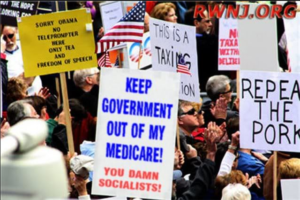 What’s going on? Why aren’t more young people flocking to take advantage of the rationalizing effect of a college education. Is stupidity in the US DNA? Have the xenophobia, hyper-militarism, devoption to exceptionalism and anti-immigrant nationalism adopted by our current and past leaders warped our priorities and infected our reason (chant heard at an anti-government rally “keep your government hands off my Medicare”). For Trumpian true believers (still a 96% approval rating among this diehard group) the role of an educated public in a democracy pales in comparison to their need to find a backstop for their fears and prejudices.
What’s going on? Why aren’t more young people flocking to take advantage of the rationalizing effect of a college education. Is stupidity in the US DNA? Have the xenophobia, hyper-militarism, devoption to exceptionalism and anti-immigrant nationalism adopted by our current and past leaders warped our priorities and infected our reason (chant heard at an anti-government rally “keep your government hands off my Medicare”). For Trumpian true believers (still a 96% approval rating among this diehard group) the role of an educated public in a democracy pales in comparison to their need to find a backstop for their fears and prejudices.
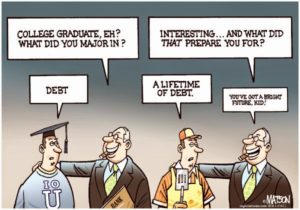 Let’s take a look at the real reason the majority of Americans do not even apply to college or leave before attaining a degree. Four words tell the tale: They can’t afford it. When Thomas Jefferson was thinking big thoughts about education, he probably never dreamed that 200 years later, forty-four million college graduates would owe a total of $1.4 trillion in student loans ($650 billion more than credit card debt). That’s not the only bad news—each indebted member of the class of 2016 owes on average $37,172, the most indebted class in history —until the class of 2017 graduates and sets another record. Is it a
Let’s take a look at the real reason the majority of Americans do not even apply to college or leave before attaining a degree. Four words tell the tale: They can’t afford it. When Thomas Jefferson was thinking big thoughts about education, he probably never dreamed that 200 years later, forty-four million college graduates would owe a total of $1.4 trillion in student loans ($650 billion more than credit card debt). That’s not the only bad news—each indebted member of the class of 2016 owes on average $37,172, the most indebted class in history —until the class of 2017 graduates and sets another record. Is it a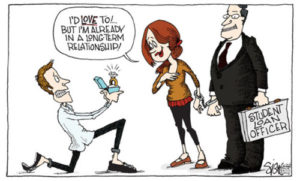 ny wonder that in 2016, 1.1 million borrowers defaulted on their federal student loans making it the second year in a row that over 1 million borrowers were unable to come up with the money to keep their loans current? In all 4.2 million people were in default in 2016.
ny wonder that in 2016, 1.1 million borrowers defaulted on their federal student loans making it the second year in a row that over 1 million borrowers were unable to come up with the money to keep their loans current? In all 4.2 million people were in default in 2016.
For young people who need financial help to afford college, escalating costs are an inescapable reality. Over the past 30 years, average tuition at public four-year colleges has risen more than 250% while family income increased 16%. Coupled with the rise in fees (at some public institutions fees increase tuition costs 27%), in 2012 (latest figures available) 83% of full-time students at public colleges received financial aid. According to their own testimony many student seeing the handwriting on the wall — their future debt burden and the hardship their families face —decide not to go to college or drop out,
For those who throw caution to the winds and graduate with a debt burden the size of a home mortgage, entry into the job market is another unpleasant shock. Not a big surprise, to be sure, it was becoming increasingly obvious to job-seekers throughout the Obama administration, but two economists from Harvard and Princeton made it official. Of the ten or eleven million jobs created in the last eight years, 95% (not a typo) are temporary, contractual jobs or part-time. This rip-off enables employers to skip the benefits they are obliged to pay full time workers. Say you get sick and you’re a part-time worker, you have two options— go to work anyway or lose a day’s pay. To put the final nail in the coffin of jobs with benefits, the report notes that full-time work is becoming as scarce as telephone land lines. One-million fewer people are now working steady jobs (i.e. full-time) than at the beginning of Obama’s presidency. According to this study young workers represent the largest growth of contract workers (dubbed free-lancers as if there’s anything “free” about their choice) who mostly do not receive any benefits even for full-time work. In this latest scam, big media companies, Viacom is a major abuser, base their business model on free-lan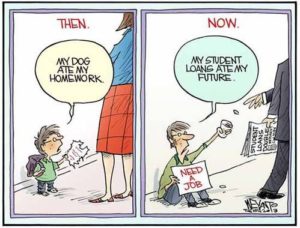 cers working full-time without benefits (a practice known as “permalance”). The “gig” economy is another jobs-with-benefits killer. Uber bases its profit-driven business model on hiring “independent contractors”— independent that is from Uber’s responsibility as employer to provide a living wage to employees like overtime pay and contributions to Social Security.
cers working full-time without benefits (a practice known as “permalance”). The “gig” economy is another jobs-with-benefits killer. Uber bases its profit-driven business model on hiring “independent contractors”— independent that is from Uber’s responsibility as employer to provide a living wage to employees like overtime pay and contributions to Social Security.
Back at the polls, the dreary statistics continue to pour in. Turnout in US presidential elections in the last two or three decades remains mired in the 50% range, a lot lower in mid-term elections. In the last mid-term election in 2014, a little over one-third of registered voters (36.7) managed to straggle into the polls (the lowest turn-out since 1942 in the middle of World War II). The majority opinion on the low turn-out — voter apathy.
A short romp through the nether regions of America’s voting habits (neglible) and corresponding educational stagnation (college enrollments static or declining in an era of escalating costs) makes one thing crystal clear: America has lots of family business to attend to. Free college education (as is the case with most of our Western neighbors) would be a terrific start. If Jefferson was right, an educated citizenry could solve many of the critical problems facing America —galloping inequality, environmental catastrophe, class and race biases —by enlightened and alert oversight on the doings in all three branches of government.
795 total views, 1 views today
